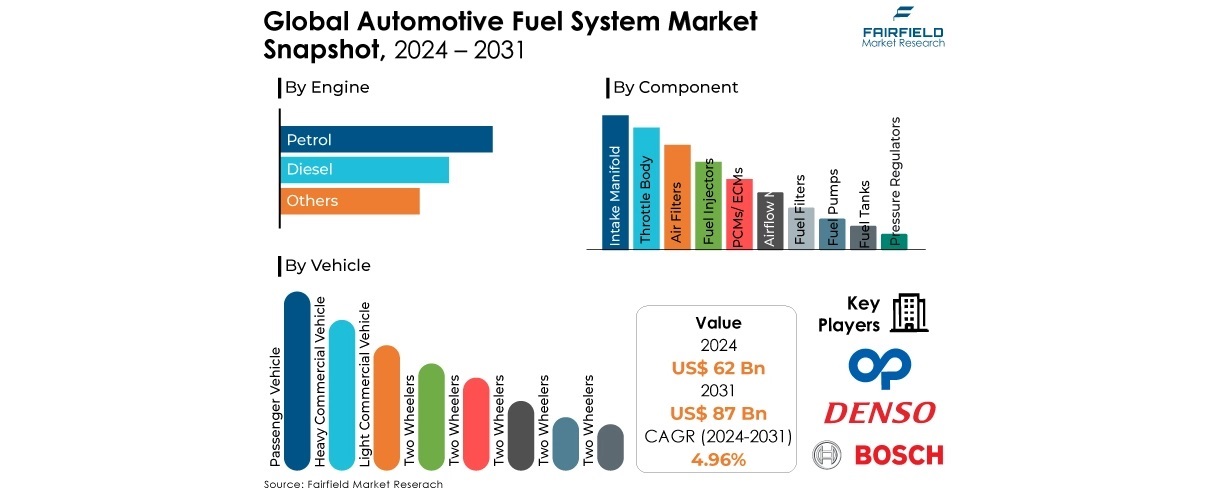Automotive fuel system market to reach $87B by 2031

London, April 18, 2024 (GLOBE NEWSWIRE) — Global automotive fuel system market is forecast to hit the gas and reach a value of US$87 Bn by 2031, according to a recent market report by Fairfield Consultancy Services. This represents a significant growth in the years to come, translating to a promising CAGR of 4.96% during the years of projection.
Despite persistent challenges such as the rise in EV popularity, crude oil price volatility, and compliance with regulations, the market roughly equals US$62 Bn as of 2024. The growth is driven by stricter emission regulations, demand for advanced fuel systems, and preventive maintenance focus.
“The initial growth drivers were fueled by high vehicle sales and a consumer preference for cars with high mileage,” says the company’s analyst, adding further, “The rising popularity of electric vehicles (EVs), and fluctuations in raw material prices however pose challenges facing the future of the market.”
Despite the rise of EVs, analysts remain optimistic about the fuel system market’s long-term prospects. A moderate CAGR of around 3.1% is expected in the coming years. This growth will be driven by stricter emission regulations, a growing demand for advanced fuel systems, and a focus on preventative maintenance in existing vehicles.
The current market landscape is complex, with internal combustion engine (ICE) vehicles still dominating the roads while EVs continue to gain traction. This necessitates adaptation and innovation in fuel system technology. Stringent emission regulations, the increasing demand for alternative fuel vehicles, and ongoing technological advancements are all key factors propelling the market forward.
While the rise of EVs may seem like a looming threat, stricter emission standards are simultaneously driving the demand for advanced fuel systems in ICE vehicles. This creates a market environment that is not only adapting to diverse fuel sources and vehicle types but also pushing the boundaries of technological innovation.
Electronic fuel injection systems, fuel pump modules, and fuel tanks are currently the top-performing segments within the market. Geographically, Asia Pacific leads in terms of volume, while North America holds the top spot for market share value. Established players like Robert Bosch GmbH, Denso Corporation, and Continental AG lead the development in the global automotive fuel system market, shaping an exciting and dynamic future.
Significant opportunities include demand for lightweight, compact fuel systems, and next-gen technologies, with growth into electric and hybrid vehicle segments. In line with a growing focus on integration and compact design, automakers are emphasizing the integration of advanced technologies and the development of lightweight, compact fuel systems. This helps them enhance overall vehicle performance and meet the growing need for space-efficient and efficient auto designs, especially in electric and hybrid vehicles.
Continuous innovation in fuel pumps, injectors, filters, and regulators improves performance, reliability, and integrates smart features, which works to the advantage of the market. Moreover, tighter emission standards push for advanced fuel systems that optimise engine performance and minimise environmental impact.
Key Research Insights
- Electronic fuel injection systems, fuel pump modules, and fuel tanks are the dominant and top-performing segments in the market. These components play a crucial role in optimizing fuel efficiency and meeting stringent emission standards.
- High demand exists for advanced fuel system technologies such as direct injection and common rail systems. These technologies improve fuel economy and reduce emissions.
- Rising popularity of hybrids and EVs creates demand for specialised fuel systems compatible with electricity, hydrogen, or biofuels.
Insights into Segmentation Analysis
Fuel Injection Takes the Lead
Electronic fuel injection systems reign supreme due to their precise fuel delivery, optimizing engine efficiency and reducing emissions.
This dominance extends across passenger cars, trucks, and light-duty vehicles.
Fuel Pump Modules Maintain Strength’
Another high performer, fuel pump modules ensure proper engine function by delivering pressurised fuel from the tank.
The demand for these modules remains robust across various vehicle segments. This is due to the ongoing adoption of advanced engine technologies and fuel-efficient designs.
Fuel Tank Segment Holds Ground
Fuel tanks play a critical role in storing and delivering fuel. They must meet stringent safety, environmental, and performance standards while adapting to different vehicle designs and fuel types.
Manufacturers address this by using advanced materials and techniques for high-quality, compliant fuel tanks.
Key Report Highlights
- Automakers seek smaller, lighter fuel systems to reduce vehicle weight and improve efficiency.
- Smart sensors, electronic controls, and predictive maintenance enhance fuel delivery, optimise combustion, and enable remote monitoring.
- Market opportunity exists for fuel system solutions specific to electric and hybrid vehicles. This includes hydrogen fuel cells and range-extender engine systems.
Insights into Regional Analysis
Asia Pacific Leads the Pack
Surging vehicle production, especially in China and India, fuels the dominance of this region. This creates a constant need for new fuel systems.
The widespread popularity of two-wheelers in Asia Pacific further bolsters its market share.
Additionally, government incentives for fuel-efficient vehicles drive the development of advanced fuel systems in the region.
North America Gears Up for Efficiency
North America’s strength comes from a robust automotive industry with a high demand for various fuel system types.
The popularity of powerful pick-up trucks creates a unique market segment here.
Moreover, North American carmakers are at the forefront of adopting advanced fuel-saving technologies. This further drives demand for compatible and sophisticated fuel systems.
